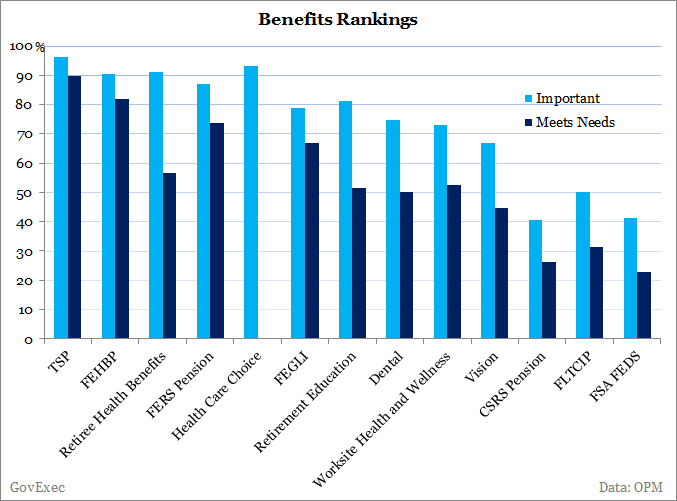The Benefits Federal Employees Love Most
Retirement and health plans rate well; some other perks are drawing very little interest.
This just in: Federal employees really like their retirement and health benefits.
OK, so maybe that is not exactly breaking news. But a recently released survey shows federal workers value nearly all of their benefits. Their satisfaction has dropped off, however.
The Office of Personnel Management first conducted the Federal Employee Benefits Survey in 2004, and has followed up sporadically ever since. The 2013 results show a few offerings have become increasingly unpopular with the federal workforce, while others have become so popular their use is nearly ubiquitous.
Generally speaking, federal employees are really happy with the Thrift Savings Plan. About 94 percent of federal workers -- who, since 2010, have been automatically enrolled in the 401(k)-type program but can opt out -- were TSP participants, the highest participation rate of any benefit program. The next highest enrollment was in the Federal Employees Health Benefits Program, which maintained an 82 percent participation rate. The Federal Long Term Care Insurance Program fell on the other side of the spectrum, with just 6.7 percent of respondents saying they participate.
OPM asked respondents to comment on the importance of each program, and the scores were up in every category since 2004 except FLTCIP, which was down 11 percent. An additional 16 percent of feds said in 2013 their TSP was important to them, compared to 2004. The importance ratings of FEHBP and workplace health and wellness programs were also up double digits.
OPM noted those programs “have become an extremely important recruitment and retention tool for employers” as a result of the current economic conditions.
The good news for federal employees is the things that are most important to them -- TSP, FEHBP health and wellness programs, as well as the Federal Employees’ Group Life Insurance Program -- are increasingly meeting their needs. The bad news: Fewer respondents in 2013 said other benefits were satisfactory compared to 2004.
This chart shows the percentage of federal employees who called each benefit important in 2013, as well as the percentage who said it met their needs:

The largest drop off in satisfaction ratings was for federal employees’ flexible spending account program, which dipped 16 percent since 2011, the last time OPM conducted the survey. Less than one-quarter of feds participated in the program. Nearly one-third of respondents said they felt they did not know enough about FSAs, while another third said they did not enroll because they were prohibited from rolling over remaining funds at the end of each year.
Generally, federal employees felt they received fair to excellent value for the money they spent on benefits. Respondents felt they received the least bang for their buck with dental and vision insurance, with 16 and 12 percent respectively saying the programs offered poor value for the money. Continuing its poor marks across the board, 24 percent fewer respondents felt the FSA program offered a good value compared to 2011.
OPM also asked employees about the federal government’s tobacco cessation benefit, but 90 percent of respondents said they did not know the benefit existed. About 12 percent of respondents said they used tobacco products in the 30-day period before taking the survey, while two-thirds said they had never used tobacco.
Overall, OPM said agencies should use targeted and specific communication efforts to better promote the full array of benefits they offer to employees.
OPM sent the survey to a random sample of nearly 39,000 employees and received a 35 percent response rate.
Want to track your TSP funds on your phone? Download the GovExec app for your iPhone or Android device.




